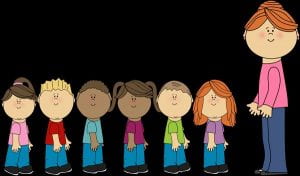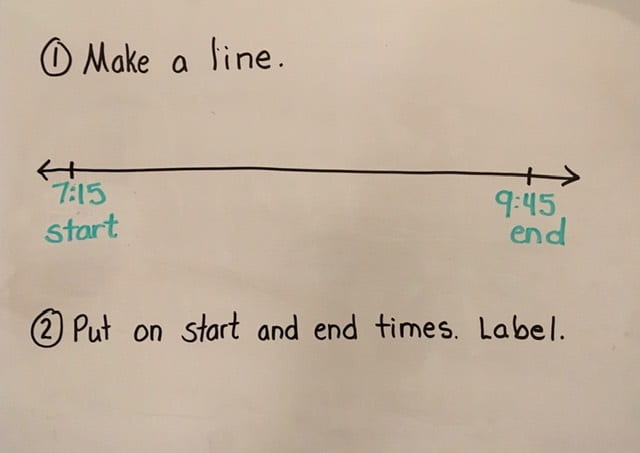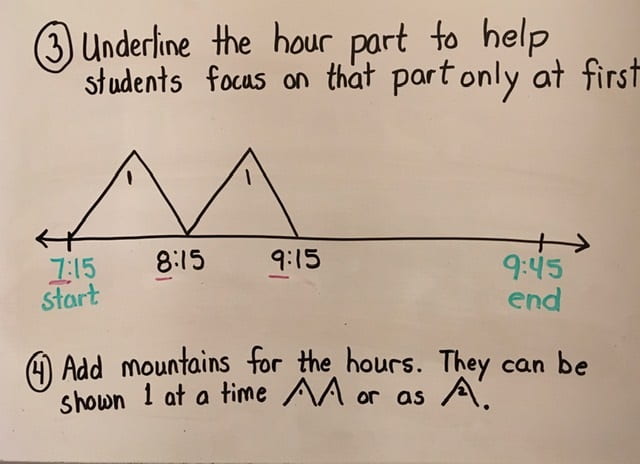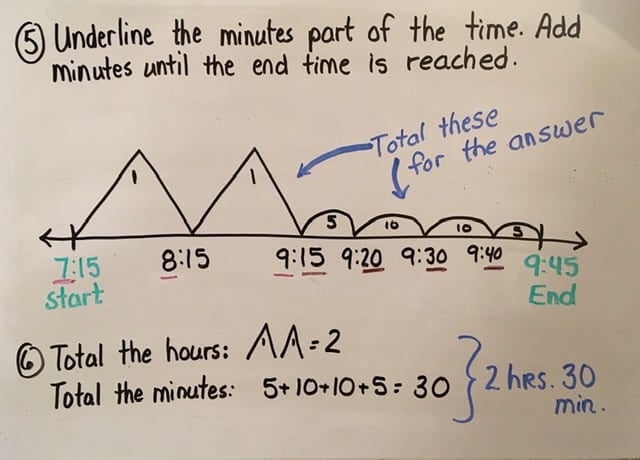by C. Elkins, OK Math and Reading Lady
Wow! What a difference a couple of weeks makes. My last post (Time Part 2) was 2 weeks ago, and life was pretty normal here then. Maybe you are using your extended time off to just try to calm down, maybe you are catching up on home chores or your favorite Netflix series, or maybe you are digging out some favorite recipes. Just in case you are using this time to help your own children with learning objectives or catching up on some PD for yourself, I am here to help any way I can. Remember in the black bar above you can access my learning aids without reading all of the articles to find them. Or type what you are looking for in the search box. Or look at the categories list to pull up by topic.
Today’s post will focus on concepts related to elapsed time.
As I mentioned in Telling Time Parts 1 and 2, it is important for students to have a concept of time. How long is a second, a minute, an hour? What tasks can be accomplished in those amounts of time. These are foundational concepts students need to better understand elapsed time. Are you making notes of time during the school day (or at home now) to make it relevant? Questions or statements such as these are helpful:
- “We have 10 minutes to finish attendance and lunch count. Look at the clock so you can keep track.”
- “Lunch will be ready at 12:00 noon. Look at the clock. It’s 11:30 now, so lunch will be ready in 30 minutes.”
- “It’s time to get ready to go home. Look at the clock. What time is it? You should be ready in 5 minutes. What time will be it then? What will the clock look like?”
- To help speed up time for transitions and work on a class management goal at the same time, try this for a procedure such as lining up:
 “Boys and girls, it’s time to line up to go to PE.” As students line up, you as the teacher will silently keep track of how much time it takes students to get ready. When they are ready, say someting like: “It took you 3 minutes 20 seconds to get ready. We miss learning time when it takes this long. Let’s see if we can beat that next time.” Most kids respond well to this mini challenge. If it’s a real contentious issue in your class, this can be followed with an easy reward such as: “It took 3 min. 20 seconds to line up and get ready. That is too long. Next time we line up if you can get ready in less than that time, I will keep track by building the word G-A-M-E. You earn a letter each time you beat the previous time to line up. The time starts when I say line up and the time stops when everyone is facing the front, quiet, and hands to themselves. You must walk to do this.” Building a short word helps students earn a reward in a short amount of time so they are more likely to strive to meet the goal. It is easy to implement and can easily be incorporated into a reading or math game. The word to build could also be F-U-N. Then it’s wide open to what that could be: A video, talk time, drawing time, a few minutes extra recess. Yes, this takes time also – but it helps students work together toward a common goal, and may save your sanity. This “time” technique can also be applied to other procedures such as getting out materials, staying quiet, etc. One hint: Don’t do a countdown or let students know how much time they are taking as you are keeping track. If you announce, “We are at 2 minutes . . . you might make it.” this gives students knowledge they have time to waste.” We are trying to build an awareness of time along with a sense of urgency and teamwork. So wait until they are all ready to announce the time it took.
“Boys and girls, it’s time to line up to go to PE.” As students line up, you as the teacher will silently keep track of how much time it takes students to get ready. When they are ready, say someting like: “It took you 3 minutes 20 seconds to get ready. We miss learning time when it takes this long. Let’s see if we can beat that next time.” Most kids respond well to this mini challenge. If it’s a real contentious issue in your class, this can be followed with an easy reward such as: “It took 3 min. 20 seconds to line up and get ready. That is too long. Next time we line up if you can get ready in less than that time, I will keep track by building the word G-A-M-E. You earn a letter each time you beat the previous time to line up. The time starts when I say line up and the time stops when everyone is facing the front, quiet, and hands to themselves. You must walk to do this.” Building a short word helps students earn a reward in a short amount of time so they are more likely to strive to meet the goal. It is easy to implement and can easily be incorporated into a reading or math game. The word to build could also be F-U-N. Then it’s wide open to what that could be: A video, talk time, drawing time, a few minutes extra recess. Yes, this takes time also – but it helps students work together toward a common goal, and may save your sanity. This “time” technique can also be applied to other procedures such as getting out materials, staying quiet, etc. One hint: Don’t do a countdown or let students know how much time they are taking as you are keeping track. If you announce, “We are at 2 minutes . . . you might make it.” this gives students knowledge they have time to waste.” We are trying to build an awareness of time along with a sense of urgency and teamwork. So wait until they are all ready to announce the time it took.
Okay, a little off topic – but showing how there are many ways to help students become more aware of time in their daily lives.
As in most story problems related to time, there are 3 components. The story gives 2 of them, and the problem is to find the missing one:
- Start time
- Elapsed time – the time it takes for something to be finished
- End time
There are several common strategies, some which are more pictorial and some which are more abstract. Of course, I am in favor of those which provide some visual representation at first such as an open number line or a Z-chart. I will feature the number line model today. More abstract models are the T-chart and lining up times vertically like you would doing a standard algorithm and adding / converting times. I’ll focus on those in future posts.
Number line: There are a few versions of time number lines out there which help students move from start time to end time. Some already have time increments noted on the line, some use jumps that all look the same. I happen to love the “Mountains, Hills, and Rocks” look because it helps immediately to differentiate between the hours and minutes and doesn’t require any advance preparation as with pre-marked number lines. The mountains represent hours, the hills increments of minutes, and rocks are individual minutes. I will share 3 types of elapsed time problems, but just elapsed time unknown in this post:
- elapsed time unknown
- end time unknown, and
- start time unknown

Elapsed time unknown: This features stories in which the start and end time are given. So students must find the elapsed time. Bobbi went to the movie theater at 7:15 p.m. It ended at 9:45 p.m. How long did the movie last?
-
- Put the known parts on the number line and label (start at 7:00 / end at 9:45).

- Underline the hour part of the number. Can we add an hour to the 7? Yes. What time would it be then? 8:15. Now here is how we show an hour (with a mountain). Can we add another hour? Yes. What time would it be then? 9:15. Add another mountain and keep track of the time under the line. Can we add another hour? No. Why not? It would be 10:15 which is past the end time.

- Now we will switch to minutes (called the hills). The hills are used to show increments of 5, 10, 15, 20, 30, etc. Since we all write different sizes, etc., I continuously tell students this: “It’s the number we write inside of the hill that matters more than the size or length of the hill.” This is because sometimes due to space limitations, my 5 min. hill looks the same length as my 10 minute hill.

- Underline the minutes part of the number 9:15. Now let’s add minutes until we get to 9:45. This can be done several ways depending on students’ understanding. I might make hills of 5 minutes each. In this problem, I might make hills of 15 minutes each. I might want to add 5 minutes in one jump to get my minutes to a number ending in 0. Some students would realize that 30 minutes would connect us from 9:15 to 9:45. When teaching and modeling, we all do the same way. Then when they seem comfortable, we look at different ways to show the same problem. This provides a safety net for some, while a challenge for those who enjoy it. For this example, I would say: “Let’s get our 9:15 to an easier time to work with . I’m going to just add 5 minutes. Looking just at the minutes part of the number, what is 15 + 5??” Yes, 20. So what time would it be now? Yes, 9:20. Our number now ends in a zero, which we can add to mentally. Let’s add 10 min. to that. What is 20 + 10? Yes, 30. So what time is it now? Yes, 9:30. Let’s add another 10 minutes. Can we do that? Yes, because 30 + 10 is 40 and 9:40 is before 9:45. Now how much time is there between 9:40 and our end time of 9:45? Yes, just 5 minutes. So that will connect us to the end time of the movie at 9:45, and we are almost done!
- The last step is to look at the numbers we wrote inside our mountains and hills and combine them. You will see Bobbi was at the movie theater for 2 hours (2 mountains) and 30 minutes (5 + 10 + 10 + 5) = 2 hours, 30 minutes.
- Put the known parts on the number line and label (start at 7:00 / end at 9:45).
Stay tuned for more examples of elapsed time problems through the next few posts. Future posts will provide some freebie story problem practice and good resources you might like. And stay safe and well!!!
I have bookmarked your site since this site contains significant data in it. You rock for keeping incredible stuff. I am a lot of appreciative of this site.https://360digitmg.com/course/certification-program-in-data-science
Thank you. I am glad you find it helpful. Watch for more new posts coming.
Thanks for sharining…
data science course in noida
Hello! I just wish to give an enormous thumbs up for the nice info you’ve got right here on this post. I will probably be coming back to your weblog for more soon!
best digital marketing courses in hyderabad
I finally found great post here.I will get back here. I just added your blog to my bookmark sites. thanks.Quality posts is the crucial to invite the visitors to visit the web page, that’s what this web page is providing.
Best Data Science Courses in Hyderabad
Thanks so much!!
Thank you so much! I appreciate your kind words. I know I haven’t put on anything new in awhile. I have some ideas, just have to get with it!!
“After reading your article I was amazed. I know that you explain it very well. And I hope that other readers will also experience how I feel after reading your article. seo service UK
Thank you! I am glad you like reading my blog. Let me know if there are topics I have not addressed that you might be interested in.
I wanted to thank you for this great read!! I definitely enjoying every little bit of it I have you bookmarked to check out new stuff you post 뉴토끼
Thank you. I’m glad it was helpful to you. Please be sure to let me know if there are topics I have not yet addressed that you might be interested in.